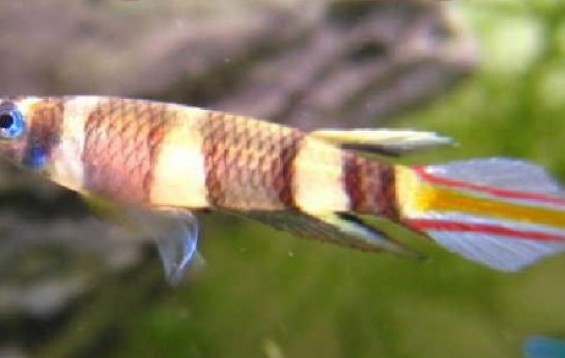- Name:
Clown Killifish
(View AKA's) - Family: Aplocheilidae
- Species: Killifish
- Scientific Name: Aplocheilus annulatus


General info about Clown Killifish
Clown Killies are cream colored and have 4 black stripes. In males the dorsal fin can be cream colored, red or blue and the caudal fin is blue and red. To keep these fish in captivity, water temperature should range from 75ºF to 80ºF and water pH should be around 6.0. The tank should have floating and rooted plants, driftwood and a sandy substrate. This species is peaceful and can be kept in community tanks with similarly sized fish. These fish should be kept in groups of 8 more.
Clown Killifish Diet & Nutrition
This species is omnivorous. It can be fed with flakes and pellets, however, its diet should also include live foods.
Determining Sex of Clown Killifish
Males are larger and more colorful.
Breeding & Spawning Clown Killifish
To breed this species in captivity, the breeding tank should have lots of rooted and floating plants and water temperature around 76ºF, there should be 2 or 3 females for a single male.
Clown Killifish Origin
This species is endemic to Guinea, Sierra Leone and Liberia.
Acclimating Clown Killifish
The water in which these fish are packaged is different from the water in the tank, since these fish are extremely sensitive to water conditions the acclimation process is very important. This process should never be rushed. Aquarium lights should be off for at least the first 4 hours of the fish in the new tank and it should not be fed in the first 24h. There are two acclimation methods: Floating Method and the Drip Method.
Floating method - the aquarium lights should be off and lights in the room should be dim, the bag in which the fish is should be placed in the surface of the water to float for about 15 minutes, this allows the water in the bag to adjust to the water in the tank. The bag should then be cut under the knot and the top edge of the bag should be rolled down one inch, then ¼ cup of the aquarium water should be added to the bag, this step should be repeated every 4 minutes until the bag is full, then half the water of the bag should be discarded and the bag should be put to float again and ¼ cup of the aquarium water should be added to the bag every 4 minutes until the bag is full. Afterwards, the Discus can be moved into the aquarium.
Drip method – the aquarium lights should be off and lights in the room should be dim, the bag in which the fish is should be placed in the surface of the water to float for about 15 minutes, this allows the water in the bag to adjust to the water in the tank. The bag contents should be poured into a 1 gallon bucket that has never been cleaned with any chemicals, the fish should be enterally submerged. A siphon, using airline tubing, should be set up and a drip line should run from the main aquarium to the bucket. Several loose knots should be tied in the airline tubing to regulate flow. Sucking the end of the airline tube that goes to the bucket will begin a siphon, the flow should be regulated to 2 to 4 drips per second. Once the water in the buckets doubles, half should be discarded and the process should be repeated until it doubles again. Afterwards, the fish can be moved to the aquarium.
Original Detail
| Name | Species | Family | Scientific Name | More Detail | Added by |
|---|---|---|---|---|---|
| Clown Killifish | Killifish | Aplocheilidae | Aplocheilus annulatus | Clown Killies are cream colored and have 4 black stripes. In males the dorsal fin can be cream colored, red or blue and the caudal fin is blue and red. To keep these fish in captivity, water temperature should range from 75ºF to 80ºF and water pH should be around 6.0. The tank should have floating and rooted plants, driftwood and a sandy substrate. This species is peaceful and can be kept in community tanks with similarly sized fish. These fish should be kept in groups of 8 more.
|
PalaciosAn |




